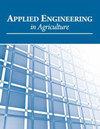A Technoeconomic Model for Estimating Costs of Harvesting and Debarking Shrub Willow
IF 0.9
4区 农林科学
Q4 AGRICULTURAL ENGINEERING
引用次数: 0
Abstract
Highlights Technoeconomic analysis helps increase understanding of the potential of shrub willow debarking and provide assessment of economic opportunities. Harvest and transport costs are increased by debarking and account for more than 50% of total costs. The fraction of clean wood material is higher when shrub willow is harvested during the dormant season. Energy to break the wood-bark bond is almost five times higher in the dormant season than the growing season. High yield of willow biomass, high wood fraction, and high field capacity have a positive influence on profitability. Abstract. A technoeconomic model was developed for integrated debarking/harvesting of shrub willow that assesses the costs associated with debarking of willow and provides a platform for estimating the minimum selling price (MSP) for separated bark material. Harvest and transport costs are influenced by the addition of a debarking process and accounts for more than 50% of the total costs of willow production. The estimated MSP for bark material is $24.53 Mg -1 when the willow biomass is harvested in the dormant season and rises to $28.65 Mg -1 when harvested during growing season. The fraction of clean wood material recovered during the dormant season harvest averaged to 72% compared to 66% in the growing season (for shrub willow cultivars in this study). Increasing the field size from 10 to 50 ha decreases MSP of bark by 47%. High yield (~26 Mg ha -1 ) creates a condition in which a producer can be profitable by selling clean wood material only (with positive NPV). Likewise, sensitivity analysis shows that under the conditions modeled in this study, shrub willow varieties with high wood fraction have a lower MSP for bark material; MSP for bark material approaches zero when the fraction of wood rises to 86.6%. Keywords: Biomass, Debarking, Shrub willow, Techno-economic analysis.灌木柳树采伐和剥皮成本估算的技术经济模型
技术经济分析有助于提高对灌木柳树剥皮潜力的了解,并提供经济机会评估。收获和运输成本因剥离而增加,占总成本的50%以上。灌木柳在休养期采伐时,清洁木材的比例较高。在休眠期,打破木树皮结合的能量几乎是生长季的五倍。柳生物量高产、木材分率高、田间容量大对盈利能力有正向影响。摘要为灌木柳树的综合脱皮/采收开发了一个技术经济模型,该模型评估了柳树脱皮的相关成本,并为估计分离树皮材料的最低销售价格(MSP)提供了一个平台。收获和运输成本受附加剥皮过程的影响,占柳树生产总成本的50%以上。在柳树休眠季节收获树皮材料的估计MSP为24.53 Mg -1美元,而在生长季节收获树皮材料的MSP则上升到28.65 Mg -1美元。在休眠季节收获的清洁木材平均回收率为72%,而在生长季节(本研究的灌木柳树品种)平均回收率为66%。将农田面积从10公顷增加到50公顷,树皮的MSP降低了47%。高产(~26 Mg / ha -1)创造了一种条件,在这种条件下,生产者可以通过销售清洁木材材料(净现值为正)来获利。同样,敏感性分析表明,在本研究模拟的条件下,高木材分数的灌木柳树品种对树皮材料的MSP较低;当木材含量达到86.6%时,树皮材料的MSP趋于零。关键词:生物量;去皮;灌柳;
本文章由计算机程序翻译,如有差异,请以英文原文为准。
求助全文
约1分钟内获得全文
求助全文
来源期刊

Applied Engineering in Agriculture
农林科学-农业工程
CiteScore
1.80
自引率
11.10%
发文量
69
审稿时长
6 months
期刊介绍:
This peer-reviewed journal publishes applications of engineering and technology research that address agricultural, food, and biological systems problems. Submissions must include results of practical experiences, tests, or trials presented in a manner and style that will allow easy adaptation by others; results of reviews or studies of installations or applications with substantially new or significant information not readily available in other refereed publications; or a description of successful methods of techniques of education, outreach, or technology transfer.
 求助内容:
求助内容: 应助结果提醒方式:
应助结果提醒方式:


